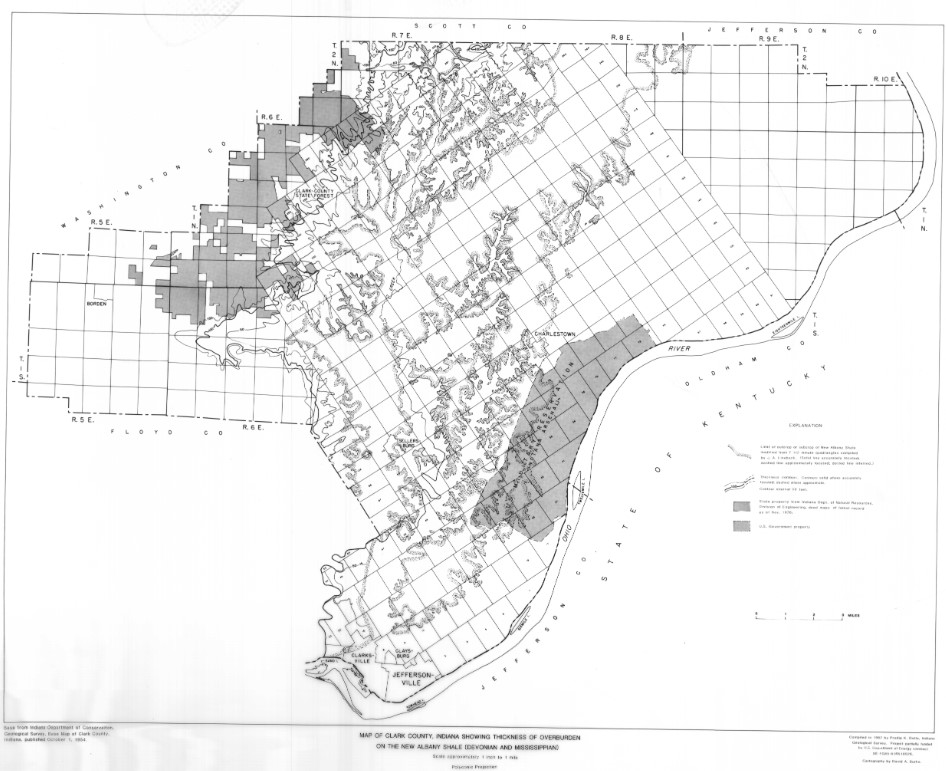ABSTRACT: The New Albany Shale in Indiana is composed of dolomitic and siliceous brownish-black carbon-rich shale, greenish-gray mudstone and shale, and minor amounts of dolomite and quartzose rocks. Five lithologically distinct members are recognized, in descending order: (1) Clegg Creek Member - massive brownish-black silty and dolomitic pyritic shale; (2) Camp Run Member - interbedded brownish-black shale and greenish- to olive-gray mudstone and shale; (3) Morgan Trail Member-brownish-black shale containing many thin pyritic beds; (4) Selmier Member-greenish-gray dolomitic mudstone; and (5) Blocher Member- brownish-black calcareous to dolomitic pyritic shale. The Blocher and Selmier Members can be traced into the subsurface of the Illinois Basin and appear to have equivalents in Illinois, Ohio, and Tennessee. The New Albany Shale above the Selmier can be divided into several lithologic units in the subsurface, but these do not appear to be directly equivalent to named surface units. The Antrim Shale, the Ellsworth Shale, and the Sunbury Shale are Michigan Basin equivalents of the New Albany Shale, and the Ellsworth Shale extends into the northeastern part of the Illinois Basin, where it is designated a member of the New Albany. Biostratigraphic studies indicate that New Albany deposition began in late middle Devonian time and ended in middle Kinderhookian (early Mississippian) time. The Devonian-Mississippian boundary is placed 2 to 6 feet below the top of the formation. The New Albany Shale was deposited in a widespread marine environment. Deoxygenated conditions caused by lack of water circulation resulted in an accumulation of organic matter as an important part of the sediment. A densely intertwined mat of floating algae is postulated as the source of much of the organic matter. Such a mat may have aided in establishing reducing conditions bye restricting wind-induced water circulation. Partial or complete destruction of the floating mat by storms or disease would have allowed deposition of sediment lacking organic matter in the areas where the floating mat was absent. The plants also might have caused precipitation of carbonate by lowering the hydrogen ion concentration of the water owning to withdrawal of carbon dioxide. A variety of evidence suggests that water depth during New Albany deposition in south-eastern Indiana was less than 200 feet but also that depth was not a factor in controlling black mud deposition.
Lineback, J. A. 1970, Stratigraphy of the New Albany Shale in Indiana: Indiana Geological Survey Bulletin 44, 73 p., 18 fig., 1 pl.
You may also like:
Keywords: New Albany Shale, stratigraphy, Clegg Creek Member, Camp Run Member, Morgan Trail Member, Selmier Member, Blocher Member, Devonian, Mississippian
Can't find what you're looking for? Feel free to contact us directly:
Indiana Geological and Water Survey
1001 E. 10th St.
Bloomington, IN 47405
812-855-7636 (phone)
812-855-2862 (fax)
IGWSinfo@indiana.edu
IGS Return Policy
- Original sales receipt required.
- Returns accepted within 30 days of purchase date.
- Refund will be issued by the same method of payment as purchased.
- Products must be returned in the same new condition as purchased.
- Refunds on custom orders and digital products are NOT allowed.
- Customers are responsible for paying shipping costs to return products.
Updated 8/19/2020




